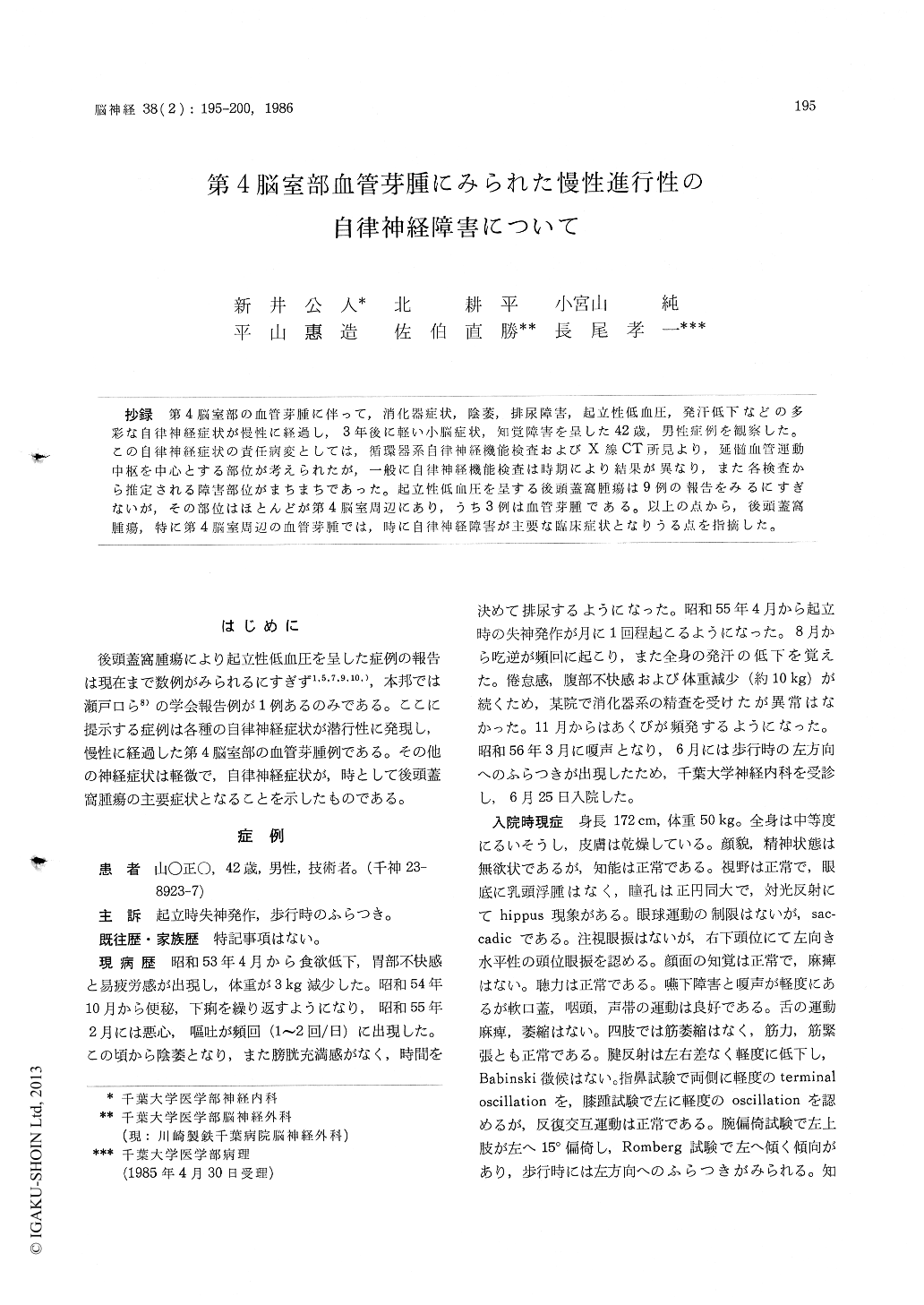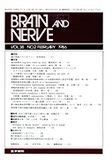Japanese
English
- 有料閲覧
- Abstract 文献概要
- 1ページ目 Look Inside
抄録 第4脳室部の血管芽腫に伴って,消化器症状,陰萎,排尿障害,起立性低血圧,発汗低下などの多彩な自律神経症状が慢性に経過し,3年後に軽い小脳症状,知覚障害を呈した42歳,男性症例を観察した。この自律神経症状の責任病変としては,循環器系自律神経機能検査およびX線CT所見より,延髄血管運動中枢を中心とする部位が考えられたが,一般に自律神経機能検査は時期により結果が異なり,また各検査から推定される障害部位がまちまちであった。起立性低血圧を呈する後頭蓋窩腫瘍は9例の報告をみるにすぎないが,その部位はほとんどが第4脳室周辺にあり,うち3例は血管芽腫である。以上の点から,後頭蓋窩腫瘍,特に第4脳室周辺の血管芽腫では,時に自律神経障害が主要な臨床症状となりうる点を指摘した。
Tumors of the posterior fossa presenting ortho-static hypotension are rare and only nine cases have been reported so far. The locations of almost all these tumors were near the fourth ventricle and three of them were hemangioblastoma.
A case of a tumor of the fourth ventricle show-ing autonomic disturbances mainly composed of orthostatic hypotension is reported. A 42-year-old male was admitted to the Department of Neuro-logy of Chiba University Hospital on June 25 th, 1981 because of three years' history of autonomic disturbances including orthostatic syncope, impo-tence, urinary disturbance and bowel dysfunction such as vomiting, diarrhea and constipation. He also complained of weight loss and staggering of gait to the left side. On admission, the patient was emaciated being 50 kg in weight and 172 cm in height.
Neurological examination revealed hippus of bilateral pupils in light reflex, saccadic eye move-ment, slightly hypoactive deep tendon reflexes, mild terminal oscillations in bilateral finger-to-nose test, oscillation in the left heel-to-knee test, stag-gering tendency of gait to the left, slightly im-paired tactile and thermal sensations in distal parts of the legs. Autonomic disturbances were showed by orthostatic hypotension (BP 104-50 in supine and 70-40 in sitting position), impotence, weight loss, anorexia, decrease of sweating, spon-taneous yawning and loss of sensation of bladder fullness. About 5 weeks after admission, he began to complain of temporal headache and showed impairment of memory, drowsiness, paroxysmal apnea and papilledema.
Autonomic function tests showed BP fall without increase of heart rate and insufficient orthostatic increase of plasma noradrenaline during head-up tilting, no response of BP rise in cold pressortest, mild BP rise in noradrenaline infusion test, low R-R interval variation of ECG, pupillary dilatation to 1.25% epinephrine and loss of dila-tation to 5% tyramine, both of which became nomalized later, and atonic bladder in urodynamic study. Acetylcholine intradermal injection at extremities showed almost normal local sweating of axonal reflex. These results, though not even in part, suggested that the autonomic disturbances were mainly derived from central lesion. Motor nerve conduction velocity and needle electromyo-gram were normal.
Brain CT scan showed a round-shaped and highly contrast-enhanced tumor in the lower half of the fourth ventricle. Suboccipital craniotomy was carried out and a vascular tumor was shown to exist from dorsal part of medulla to cerebellar vermis. On biopsy, histological diagnosis of hemangioblastoma was made.
The feature of this case was that the main symptoms were not cerebellar ones, but autonomic disturbances mainly composed of orthostatic hypo-tension. The lesions responsible for the autonomic disturbances were thought to be mainly in the lower brain stem including vasomotor center of the medulla oblongata and partly in the cerebellar vermis which has been demonstrated to play some role in the control of the autonomic nervous sys-tem. Autonomic disturbances can be such impor-tant clinical features in cases of posterior fossa tumor that we should always keep this possibility in mind in the case of orthostatic hypotension.

Copyright © 1986, Igaku-Shoin Ltd. All rights reserved.


